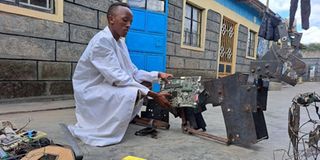Teen develops robot to help soldiers detect, detonate bombs

Lawrence Kamau display his robotic prototype at their home in Mzee Wanyama area in Nakuru County. He hopes the project will be adopted and improved so that it can used by security forces to fight terrorism
A 19-year-old boy from Mzee wa Nyama, Nakuru County, is developing a robot that can help Kenya soldiers counter terrorism and reduce casualities in the frontline.
David Lawrence Kamau said the prototype, which resembles a dog, will help soldiers detect, disarm and detonate explosives set up by enemies in battlefields.
He said he has been working on the project for the past seven years using locally available materials.
The robot, which he calls by the Latin scientific name Android Familiares, can be armed with guns and detect explosive devices from as far away as 200 metres.
“I came up with the idea when I was in primary school. The reason behind it was insecurity, especially at our borders,” he said.
“I felt that our security forces needed assistance. The robot will just be weaponised for that task. We don’t want to lose our soldiers.”

Lawrence Kamau displaying a sketch of the prototype
He works on the project in his free time in a temporary workshop at his home and hopes the idea will be adopted by the Defence ministry.
The first-year student at Thika Technical Institute believes that the diploma in electrical and electronic engineering that he will get will enable him to realise his dream.
He said building a robot combines ICT, mechanics and electronics, besides research.
He said this is the sixth robot he has developed through trial and error.
He said he made his first robot when he was 14 years old. The raw materials required to make the prototype are hard to acquire, forcing him to use what is readily available, he said.
“You know, a robot is a computer and computers are very accurate, so the chance of mistakes is very minimal compared to humans. There is no need to expose our soldiers to certain hazards,” he said.
“If the machine is destroyed, it is different from a person being killed. You can replace the machines but not a human life, so this will be good,” he said
Kamau has modified a software programme that will control and communicate with the robot, but he doesn’t have enough money to complete the project.
He urged the government to support young scientists.
His mother, Rose Kimani, said Kamau started working on projects like this when he was still young and would not let her throw away his used toys as he kept them together for recycling.

Lawrence Kamau displays some of the materials he used to create the robot prototype
She recalled when her son was in Standard Three and made a wooden aeroplane as a school project and was recognised with a gift from his teachers, motivating him to do more.
She said he participated in school competitions as he grew older, winning awards, but she never thought he could one day develop a robot.
“At first, we used to wonder what he was doing, but with time we came to understand him and we started supporting his passion,” she said.
“We normally help him financially where we can. Sometimes he calls when he is in school and asks us to go look for some parts he needs and even though sometimes we do not know what they are and what they are for, we just ask about them in electronics shops.”




